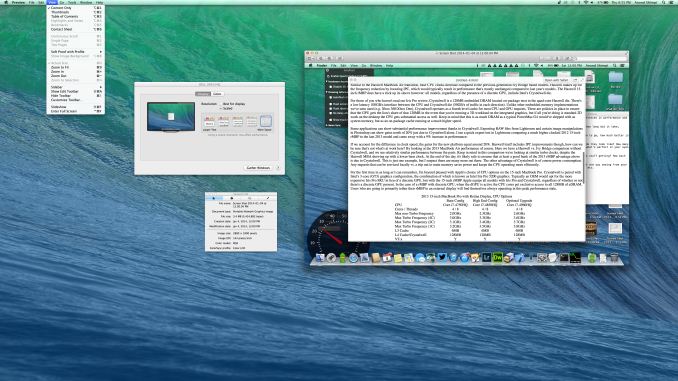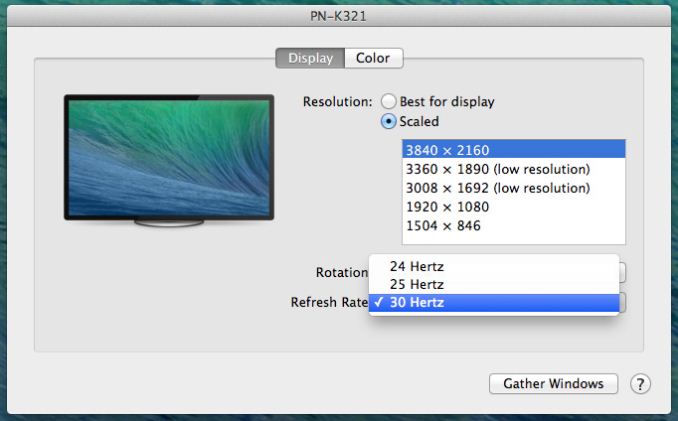Testing Improved 4K Display Support in OS X 10.9.3
by Brandon Chester & Anand Lal Shimpi on May 15, 2014 7:11 PM EST
Today Apple released the long awaited OS X 10.9.3 update. The update comes after nine weeks of beta testing, each week with a new release. One of the most interesting things about the update is not in its content but in how Apple opened up their beta seed program to all users when it was traditionally reserved for those who are part of Apple’s developer program.
The most major improvement of the update is the improved 4K (3840x2160) display support on OS X. Prior to 10.9.3 the support for 4K displays on OS X was lacking. Only a small group of monitors from ASUS and Sharp were supported for running at 3840x2160 with a 60Hz refresh rate, and the scaled display options that Apple introduced with the original Macbook Pro with Retina Display were unavailable. This made for poor usability on monitors like the Dell UP2414Q which is only 24” and has extremely small UI elements when running unscaled at its native resolution. In 10.9.3 Apple has greatly expanded the list of compatible 4K displays and has introduced scaling modes for those who prefer sharper UI elements over display real estate.
Anand took a look at the changes to 4K support in the first beta of 10.9.3. Apple now gives the user options for display scaling which includes settings for a workspace that looks like 3200x1800, 2560x1440, 1920x1080, or 1280x720. All of these are handled the same way as on the Macbook Pro with Retina Display where the display is rendered offscreen at twice the selected vertical and horizontal resolution and then scaled down to the panel. In the case of the 3200x1800 setting this means that the display is rendered offscreen at 6400x3600 which may cause performance issues when being driven with the Intel Iris graphics of a Macbook Pro with Retina Display or the entry level 21.5” iMac.
With 10.9.3 Apple has not only broadly increased support for 4K displays, but also enabled 60Hz output to 4K displays on more systems. The Dell UP2414Q, a 24" 3840 x 2160 display, is now properly supported by OS X and Macs that can drive it at its native resolution. Apple appears to have manually added a profile for the UP2414Q as its scaled resolutions are somewhat different from the 30" Sharp/ASUS 4K panels.
| Apple OS X 10.9.3 4K Display Handling | ||||||
| Scaled Resolution | ASUS/Sharp 30" 4K | Dell 24" 4K (UP2414Q) | ||||
| Best for Display Setting | 3840 x 2160 | 1080p Hi-DPI | ||||
| Scaled Resolution 1 | 1504 x 846 (3008 x 1692) | 1504 x 846 (3008 x 1692) | ||||
| Scaled Resolution 2 | 1920 x 1080 (3840 x 2160) | 1920 x 1080 (3840 x 2160) | ||||
| Scaled Resolution 3 | 2560 x 1440 (5120 x 2880) | 2304 x 1296 (4608 x 2592) | ||||
| Scaled Resolution 4 | 3008 x 1692 (6016 x 3384) | 2560 x 1440 (5120 x 2880) | ||||
| Scaled Resolution 5 | 3840 x 2160 | 3008 x 1692 (6016 x 3384) | ||||
There is no native 3840 x 2160 resolution exposed on the UP2414Q and by default OS X appears to want to run the panel in a 1080p Hi-DPI mode. This is similar to what happens on the rMBPs where text/UI elements appear as they would on a 1080p display, while images, videos and other similar objects appear as they would on a 3840 x 2160 display.
The 24" 4K panel gains a new intermediate scaled mode of 2304 x 1296. The table above shows the frame buffer resolution in paratheses. For example, the screenshot below was taken with the UP2414Q set to its highest scaled resolution (3008 x 1692). The full untouched PNG weighs in at 19.8MB from OS X and is a 6016 x 3384 image. At the highest scaled resolution setting the frame buffer is now over 20 megapixels (excluding the 5MP primary Retina Display), which is just insane. The screenshot open in Preview (screenshot within the screenshot) is a 2880 x 1800 screenshot, open at full size. Note how little space the screenshot occupies. Apple's Hi-DPI scaling and seamless integration across the ecosystem continues to be awesome.
Along with expanded display support, some new Macs also get the ability to drive 4K panels at 60Hz. By some I mean one: the 15-inch MacBook Pro with Retina Display from late 2013. This is the Haswell refresh of the rMBP15, and it remains the only portable Mac capable of driving a 4K panel at 60Hz over either of its two miniDP ports (HDMI is limited to 30Hz).
The 13-inch Haswell rMBP unfortunately doesn't support 4K60, although you can use its HDMI port to drive a 4K panel at 30Hz (I noted MST compatibility issues when trying to use the 2013 rMBP13's miniDP out). I suspect this has more to do with performance than a physical hardware limitation, as even running the 13-inch rMBP's primary display at a high frame rate can be a chore with a lot of windows open. The 15-inch 2013 rMBP forces the use of its GeForce GT 750M whenever you connect an external display, which helps ensure a better experience when driving a couple of high res displays. Obviously the new Mac Pro works just fine with these displays as well.
Update: As many of you have pointed out, the base 15-inch 2013 rMBP also lacks a discrete GPU. Apple doesn't specifically exclude the entry level 15-inch rMBP in its release notes. Driving ultra high resolutions (up to nearly 26MP across two displays) is mostly an exercise in memory bandwidth and ROP performance. The 15-inch rMBP benefits from having Intel's Crystalwell eDRAM on-package, which should help tremendously in the memory bandwidth department at least. If anything, the lack of Crystalwell is probably what keeps the 13-inch rMBP from getting access to the higher scaled resolution modes at least.
Beyond the improvements to 4K support Apple has also included various stability and security improvements. 10.9.3 also bundles the Safari 7.0.3 update which brings along its own bundle of security patches. The full changelog for the update is as follows:
- Improves 4K display support on Mac Pro (Late 2013) and MacBook Pro with 15-inch Retina Display (Late 2013)
- Adds the ability to sync contacts and calendars between a Mac and iOS device using a USB connection
- Improves the reliability of VPN connections using IPsec
- Resolves an issue that prevented Font Book from installing PostScript Type 1 fonts
- Improves reliability of copying, editing and inspecting permissions of files on an SMB file server
- Improves reliability of network home directories
- Improves stability when installing configuration profiles
- Improves login speed for users in Active Directory groups
- Includes Safari 7.0.3
OS X 10.9.3 is available now to all Mac users with a computer that supports OS X Mavericks. The changelog for the update is available in the source below and Apple will put up a page detailing the security content of the update on their security page shortly.
Source: Apple












72 Comments
View All Comments
Morawka - Friday, May 16, 2014 - link
Why doesnt the 2012 15" Retina Macbook Pro's get 60hz 4K support as well? they have a almost identical dedicated GPU (Nvidia 650M). And every 2012 15"r has dedicated graphics, unlike the 2013 models.Morawka - Friday, May 16, 2014 - link
nevermind, dis-regard, it has been talked about on page 3chasmac - Saturday, May 17, 2014 - link
Anyone else having issues running 3 monitors?repoman27 - Saturday, May 17, 2014 - link
Yes, it seems that 10.9.3 breaks things for some multi-monitor setups. For some folks, downloading and installing the combo update and/or resetting PRAM fixed the issue. For others, rolling back to 10.9.2 was required.karanm - Saturday, May 17, 2014 - link
Sorry, this may have been answered in the comments, but I'm seeing a bit of conflicting information. I have a 13" MBPr Late 2013. If I get the Dell UP2414Q, can I drive 4K@60 with the DP? The article and some comments make me think no, but the Apple Support article (http://support.apple.com/kb/HT6008) doesn't differentiate between 15" & 13" and seems to allude that it is possible by changing the display settings.Also, if it is possible, can I still use the internal display at the same time I'm using the Dell running 4K60?
Thanks
neurack - Sunday, May 18, 2014 - link
Unfortunately the 10.9.3 release notes themselves are the accurate ones. Late 2013 15" MBPs only at this point. It'd be great to see that support widened to the 13"- but Apple may not be satisfied with the 4k/60hz performance of the non-Pro Iris that doesn't have the eDRAM for extra bandwidth like the 15"...samdale67 - Tuesday, May 20, 2014 - link
So perhaps a big ooops here. I've just ordered the UP2414Q, going by the clear (and official) documentation referenced above that both MBP late 2013 will drive it at 60hz. How could Apple have made such a mistake in this document--if indeed it is a mistake. Language quoted here: "MacBook Pro (Retina, Late 2013) or Mac Pro (Late 2013) also support 60 Hz displays using multi-stream transport (MST). These displays need to be manually configured to use MST. Follow the steps below to use the display's built-in controls to enable this feature."samdale67 - Tuesday, May 20, 2014 - link
Clarifying that I do have the 13" late 2013 MacBook Pro.rockadoodledoo - Sunday, May 18, 2014 - link
Can the 15'' MBP with the discreet graphics only run 1 4k External Display at 60Hz? I know it can run 2 4k display's + its own display but I haven't got a chance to try it at 60Hz. My display maxed out at 50Hz so I returned them - I'm now wondering if I should pull the trigger on dual new 4k Sammy's?repoman27 - Sunday, May 18, 2014 - link
Highly unlikely. 4K displays count as two displays, and the NVIDIA dGPU only supports 4 display outputs. If it were possible, it would have to blank the built-in panel, and it would require the driver to be capable of creating multiple display groups. Can any NVIDIA GeForce cards even drive dual 4K displays at 60 Hz under Windows with stock drivers?